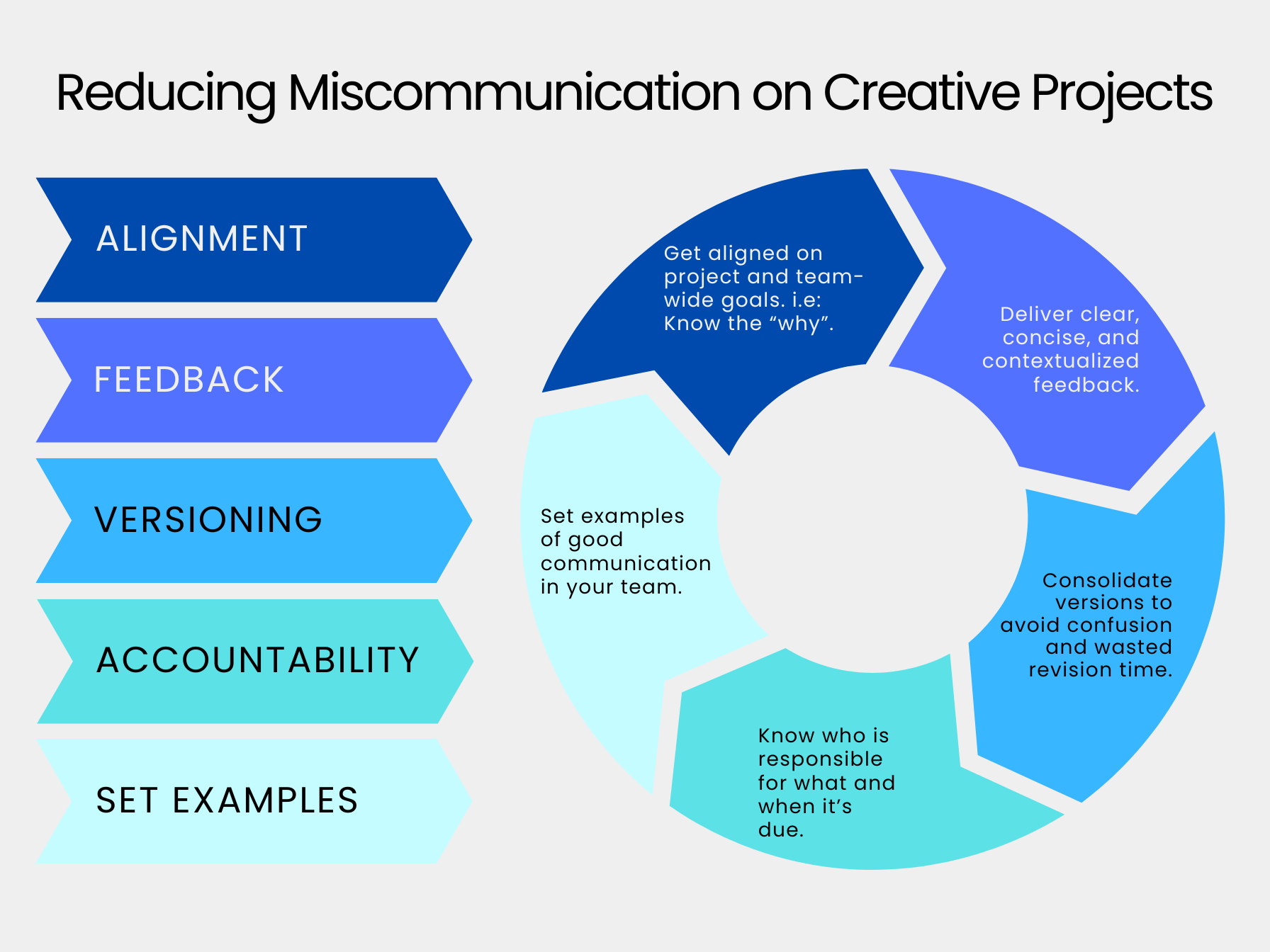How familiar does this scenario sound to you?
Someone on your team misunderstood the assignment. Another misinterpreted a key piece of feedback. Someone else made amends to an outdated file.
And that lingering task? No one knew it was their responsibility.
It all gets chalked up to little mistakes. The feedback gets clarified. The amends are eventually done to the right file. The task ultimately gets completed. A few extra meetings, and the creative is delivered. You move on.
However, the time and resources spent fixing errors caused by poor communication quickly add up. Miscommunication, poor feedback, and other symptoms of a broken workflow could be costing your business more of a financial strain than you realize.

The Cost of Poor Communication
There are multiple ways miscommunication hits the bottom line for companies. But at a high level, it comes down to productivity setbacks caused by poor communication and feedback processes.
Here are 4 obvious ways that miscommunication directly affects your bottom line:
- Missed Deliverables – Run-ons in projects mean delayed payments or worse. Plus, unhappy creatives, managers, and clients.
- Too Many Meetings – Inefficient communication can mean wasteful meetings needed to gain clarity, get projects back on track, or (re)alignment.
- Unnecessary Revisions – Miscommunication leads to preventable mistakes, such as working on the wrong file version. It wastes time, energy, and resources.
- Scope Creep – Too many revisions will kill your margins, and every extra hour reduces the likelihood of profit.
And though it’s difficult to quantify exactly how much time and resources miscommunication within your team and larger organization are costing you, the output doesn’t lie. When workers misunderstand or are misinformed about a task or project feedback, it will have a financial impact.
The More Hidden Costs of Miscommunication
From obvious errors to run-on projects, meetings to missed deliverables, there are plenty of consequences to miscommunication that are plain to see. But when stacked, it’s the larger effects that can really add to undesirable costs.
Poor Creative Executions
It is very apparent when miscommunication leads to delayed deliverables or missed deadlines. The proof is in the calendar. But what may not be as obvious is what was delivered can often suffer.
Often, when faced with overdue work, creatives and others involved can start to cut corners (and their losses). The result is work designed to simply get it done and move on. This is compounded when creatives are frustrated with an unclear feedback loop.
Miscommunication Kills Accountability
The concept of accountability within a team is something often only remarked on when it’s bad. The signs are obvious – tasks are missed, and balls are dropped. It’s largely because either nobody knows who is responsible for what, or people aren’t willing to accept the responsibility for errors.
Lost Business
When internal and/or external communication is off, it’s bound to impact customer relationships. Consistently poor communication will likely lead to them moving on. Not only that but when you aren’t communicating well internally, creative work suffers, too. And that will eventually hurt any agency or team.
Why Your Team’s Communication Cycles Are Broken
Poor communication is one of several symptoms of what we refer to as a broken workflow. These symptoms plague creative teams by leading to the unfortunate and costly results mentioned above. But how to fix a broken workflow suffering from chronic miscommunications?
To prevent frustration and misunderstandings, addressing the causes of poor communication is a good starting point.
Some Key Reasons Creative Teams Suffer from Miscommunication
- Not being aligned on project or company-wide goals and targets.
- A lack of the soft communication skills among employees and/or leadership.
- Not having a clear process for assigning tasks.
- Giving and receiving poor or unclear feedback.
- Feedback and critical project information stays siloed across various channels.
- Not having the right tools to keep workflows on track.
Proper communication, specifically regarding alignment on project goals and tasks, is a big one for many teams. When communication is not on track, this shows up as broken project workflows, which presents as misunderstood tasks, a lack of accountability, and unclear feedback.
When feedback is delivered but is unclear or hard to locate, this can lead to confusion. Working across various platforms or channels is a sure way to cause miscommunication somewhere along the way. And with 55% of companies working in these types of silos, it’s a common occurrence.
Fixing Poor Communication
To reduce high miscommunication costs, it’s important to actively correct the root causes of your team’s workflow issues. Establishing effective communication will result in higher productivity, better creative, and a stronger bottom line.
How to Help Improve Communication:
- Get aligned on goals.
- Deliver clear, concise feedback.
- Consolidate versions of project files and assets.
- Establish accountability (know who’s responsible for what).
- Set good communication examples.

Establishing alignment, giving clear feedback, and setting up a smooth workflow isn’t always easy. It’s important to remember that different people are equipped with different communication skills, which can lead to barriers if not addressed with sensitivity and patience.
These actions for reducing miscommunication are made a lot simpler by selecting the right tools for communication and the exchange of clear, precise feedback.
With the right tools, creative teams can reduce their costs and their chances of miscommunication. A team or project-wide project management tool can keep workflows on track. Integrating with an online proofing platform can further increase the clarity of feedback and accountability within a creative project – as well as keep multiple versions organized and varying stakeholders on the same page.
Miscommunication Doesn’t Have to Break the Bank
Miscommunication can have a significant impact on businesses, affecting productivity, employee well-being, customer satisfaction, and your bottom line.
But by improving communication, aligning goals, delivering clear feedback, establishing accountability, and using the right tools, you can enhance efficiency, reduce errors, and save your organization the financial strain of miscommunication.






